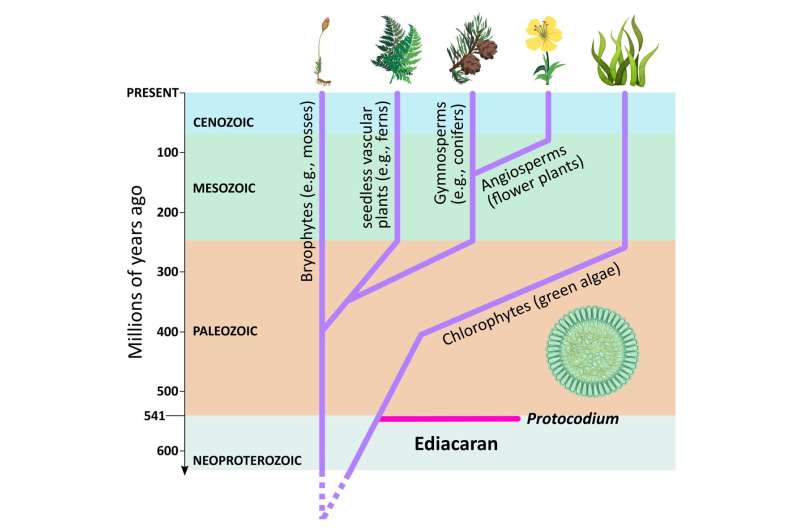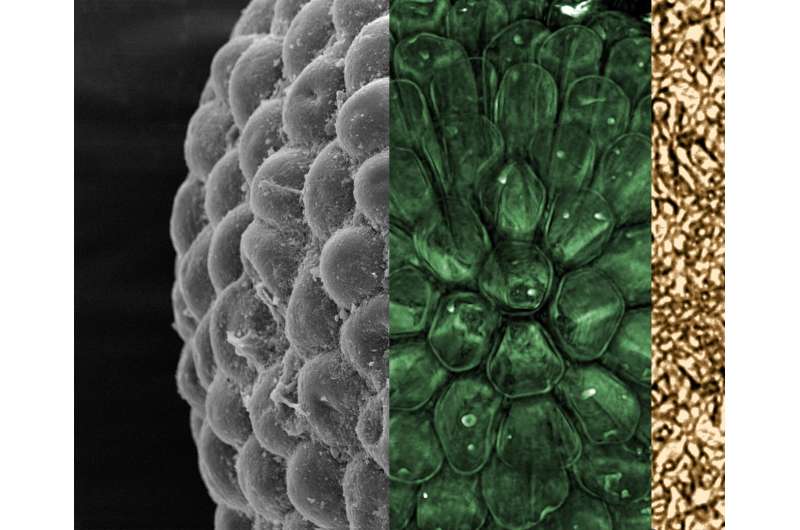Reconstruction of a cross-section through Protocodium sinense showing resemblance to modern Codium. Photo credit: Shu Chai
Paleontologists have identified a new algal genus and species called Protocodium sinense, which arose before the emergence of land plants and modern animals, offering new insights into the early diversification of the plant kingdom.
This 541-million-year-old fossil, discovered at a site in China, is the first and oldest green alga from that period to be preserved in three dimensions, allowing researchers to study its internal structure and identify the new specimen with unprecedented accuracy. The study is published today in BMC biologyand opens a window into a world full of evolutionary mysteries that scientists are only just beginning to unravel.
“Protocodium belongs to a well-known lineage of green algae and has a surprisingly modern architecture, showing that these algae were well diversified even before the end of the Ediacaran period,” says co-author Cédric Aria, a postdoctoral researcher in the Department of Ecology and Evolution Biology from the University of Toronto Faculty of Arts & Science and the Royal Ontario Museum (ROM). “His discovery touches on the origin of the entire plant kingdom and gives a familiar name to the organisms that preceded the Cambrian explosion over half a billion years ago, when the world’s first modern ecosystems formed.”

Images of Protocodium sinense using electron microscopy (A) and X-ray computed tomography (BD). Panels BD show the internal structure. Credits: Shu Chai, Cédric Aria and Hong Hua
The newly discovered Protocodium fossils were found by a team led by Hong Hua, professor of geology, and Shu Chai, postdoctoral researcher, both from Northwest University, Xi’an, China. It is part of the Gaojiashan Biota, the name of an important group of exceptionally well-preserved fossils in the Dengying Formation in southern Shaanxi Province. Over the past 20 years, this geological formation has yielded important fossil species documenting the end of the Ediacaran period 541 million years ago.
Organisms and their parts that do not originally hold minerals – unlike shells or bones – require exceptional conditions to be preserved. In this case, the entire fossil and its fine cellular details were preserved in three dimensions because the original organic material was replaced with phosphate. This type of preservation allowed the researchers to use various electron and X-ray microscopy techniques to virtually section the fossil, precisely revealing its internal structure and eventually identifying it as a close relative of the modern Codium alga, a species of algae.
Protocodium fossils are small spheres, half a millimeter in diameter, like large pollen grains, covered by a multitude of smaller domes. Thanks to the 3D study, the researchers determined that the domed surface is part of a complex single cell containing thin strands called siphons. This morphology is typical of certain modern unicellular algae that contain many nuclei.

Simplified phylogeny, or tree of life, showing the relationship of Protocodium and other green algae known as chlorophytes to other important plant lineages. Credit: Cedric Aria
The discovery of Protocodium would urge caution in identifying generic spherical Ediacaran fossils and imply that organisms like Codium are actually much older and more widespread. The famous Doushantuo fossil embryos, also from China and preserved in 3D, have been at the center of debates about the deep origins of certain animal groups. Certain stages of some of these animal-like embryos resemble the single-celled protocodium externally, but 3D sections show how they are made up of many cells. On the other hand, numerous round 2D fossils with uncertain algal or other affinity from the Ediacaran and older periods are also known, but in less detail.
“We know that algal-like fossils are at least a billion years old,” says Chai, the study’s first author. “But so far, the flat, granular two-dimensional preservation has made it difficult to discern more than general morphological structures.”

Combined image showing the outer surface of Protocodium sinense (left), looking through the outer layer composed of utricles (middle, colorized) and central siphons (right, colorized). Credit: Cedric Aria
Green algae are photosynthetic organisms, meaning they convert light and carbon dioxide into sugar and oxygen. They were therefore likely important foundations of Earth’s early ecosystems, and the study suggests that green algae were already well established in the world’s shallow waters as carbon dioxide recyclers and oxygen producers before the Cambrian explosion.
Aside from its smaller size, Protocodium appears to be surprisingly identical to modern Codium, a species of green algae found in many seas around the world. Certain species of these algae are notoriously invasive — like Codium fragile subspecies tomentosoides, nicknamed “dead man’s fingers” for their appearance, and spread alongside commercially farmed shellfish. From an evolutionary perspective, green algae, like ancient Protocodium and land plants, share a common ancestor that has been thought to be around a billion to a billion and a half years old, but is now likely older — assigning Protocodium so close to a modern group puts the History of the entire plant kingdom in the past.
“It is very revealing that such an organism remained virtually unchanged for at least 540 million years,” says Aria. “With the Ediacaran, evolution had pushed it towards a stable zone of adaptation – it has been comfortable there ever since, and even more so, quite successfully. So much so, in fact, that Codium now uses global trade to easily outperform other species of algae.”
Scientists take a close look at the first animals on earth
A Codium alga from the stem group of the most recent Ediacara from southern China provides a taxonomic insight into the early diversification of the plant kingdom. BMC biology (2022). DOI: 10.1186/s12915-022-01394-0
Provided by the University of Toronto
Citation: Three-dimensional fossil algae more than 541 million years old reveal modern-looking ancestors of the plant kingdom (2022, September 20), retrieved September 21, 2022 from https://phys.org/news/2022-09-three -dimensional- fossil-algae-millions-of-years.html
This document is protected by copyright. Except for fair trade for the purpose of private study or research, no part may be reproduced without written permission. The content is for informational purposes only.
#Threedimensional #fossil #algae #million #years #reveal #modernlooking #ancestors #plant #kingdom


Leave a Comment